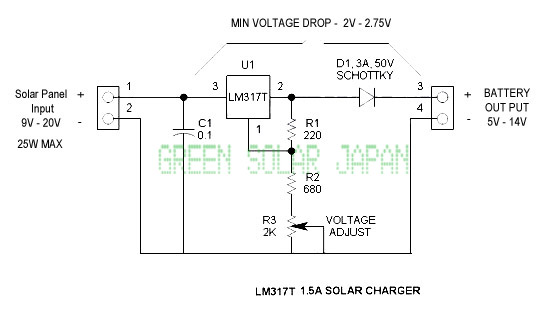Solar charge controller- LM317 (1.5A Max) |
This is the most simple and affordable solar battery charger that the hobbyist can make. It has a few drawbacks over other similar controls, but offers numerous advantages. It is intended for charging lead-acid batteries, but may also be used for charging any battery at a constant voltage. Voltage output is adjustable.
Advantages & Disadvantages of this solar charger
- + Simple, small & inexpensive
- + Uses commonly available components
- + Adjustable voltage
- + ZERO battery discharge when sun is not shining
- – High drop-out voltage—may be marginal for 6V application
- – Current limited to 1.5A
- – No LED indicators—no bells or whistles
Solar battery charger specifications
- Solar panel rating: 20W (12V) or 10W (6V)
- Output voltage range: 5 to 14V (adjustable) (may be reduced further by shorting R2)
- Max power dissipation: 10W (includes power dissipation of D1)
- Typical dropout voltage: 2 to 2.75V (depending upon load current)
- Maximum current: 1.5A (internally limits at about 2.2A)
- Voltage regulation: ±100mV (due to regulation of series rectifier)
- Battery discharge: 0mA (this control will not discharge the battery when the sun doesn’t shine)

6V Battery
- Output Voltage: Set for 7V
- Input voltage:
- Battery discharged (6V): 8.75V Min @ 1.5A (this is a little high for panels that are characterized for 6V applications)
- Battery charged (7V): 9V Min @ 10mA (e.g.)
12V Battery
- Output Voltage: Set for 14V
- Input voltage:
- Battery discharged (12V): 14.75V Min @ 1.5A (Available from solar panel characterized for 12V operation)
- Battery charged: (14V): 16V Min